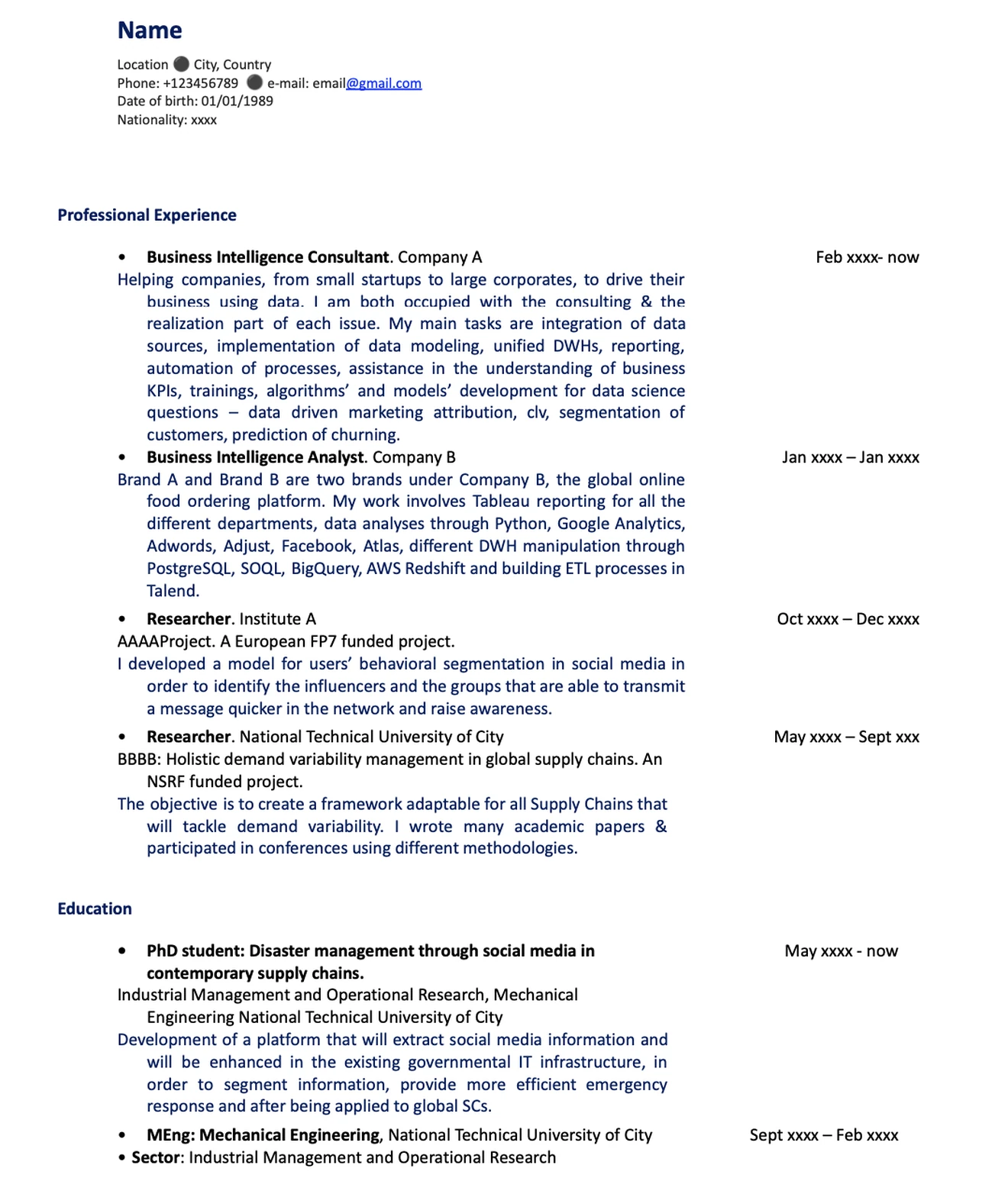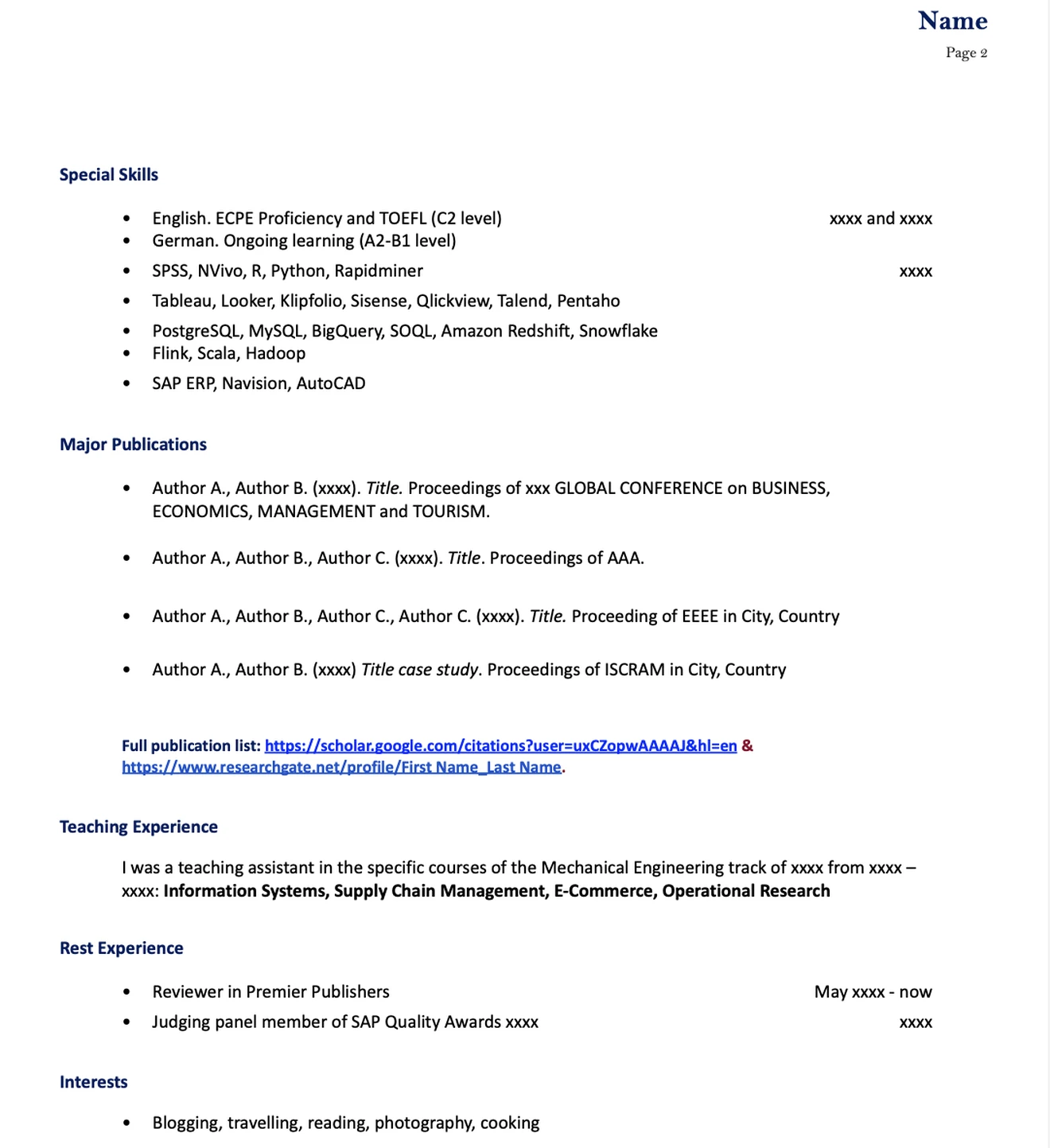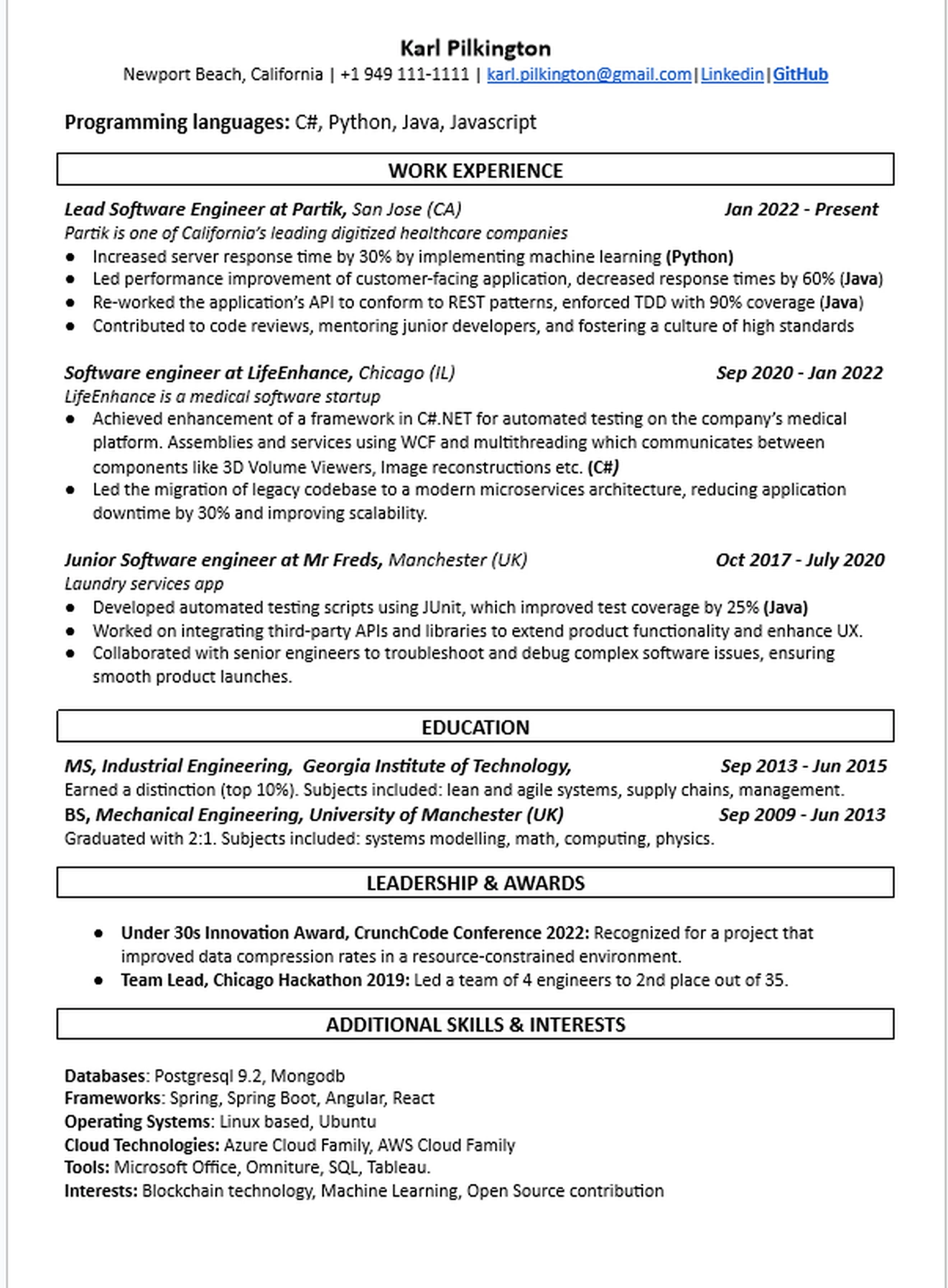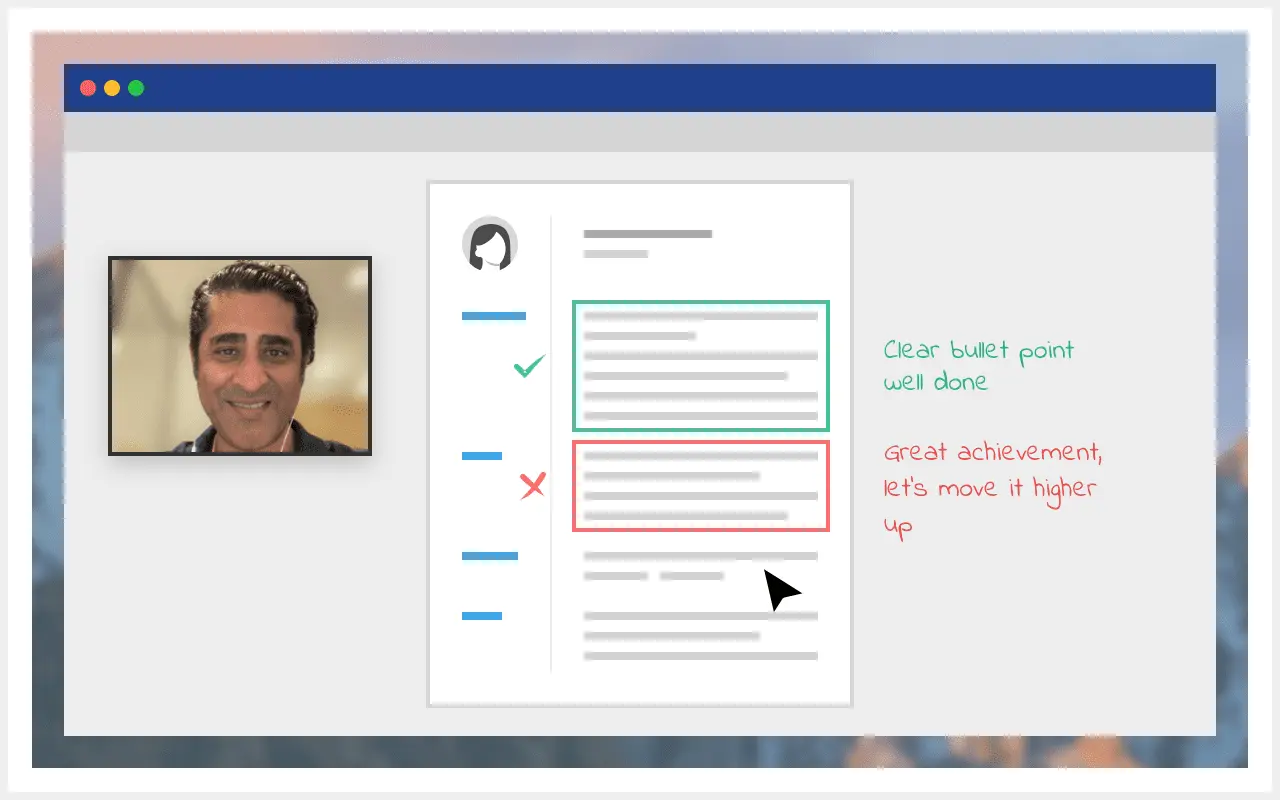Meta is one of the most prestigious tech companies in the world, so it goes without saying that it’s tough to get into.
But before you can even think about their highly rigorous interview process, you first need to get your resume noticed.
To help you increase your chances of clearing the resume screening, we’ve prepared a step-by-step guide to writing a top Meta resume/CV.
It includes tips and expert insights as well as REAL examples of resumes that earned candidates offers or interviews at Meta. We also have a template that you can use as a guide to get started.
Here’s an overview of what we’ll cover:
- 6 Meta resume tips
- 5 real resume examples that worked for Meta
- Meta resume template
- How to write a resume for Meta (section-by-section)
- Your Meta resume checklist
Let’s get into it.
Click here to get expert feedback on your resume from an ex-Meta recruiter or interviewer
1. 6 Meta resume tips↑
As you'd expect, Meta recruiters have the highest standards. They also have certain things that they are particularly keen on, so, no matter what role you're applying for, follow these six crucial tips:
1.1 Use the X, Y, Z formula for your achievements
The "Accomplished [X] as measured by [Y] by doing [Z]" formula is great for structuring your bullet points and really showing quantifiable results and impact on your resume.
The format was made famous by ex-Google VP Lazlo Bock, but it’s not just for Google. It’s an excellent format to use on your resume, no matter where you’re applying.
Examples:
"Achieved a 40% reduction in critical bug resolution time by leading a cross-functional team and implementing immediate code fixes."
"Achieved a 25% increase in user NPS scores by initiating a customer-centric approach based on extensive user research and feedback analysis."
1.2 Demonstrate leadership skills
Meta has traditionally upheld a bottom-up culture, although it has become a blend of top-down and bottom-up approaches in recent years.
Still, it grants lots of autonomy to its engineers and product managers, so it doesn't want to hire people who are only good at executing tasks and following established processes.
Regardless of whether you're applying for a leadership role or not, Meta wants to see that you have what it takes to be a leader.
So include examples where you led a project, took the initiative, or influenced other people. You may want to include a "Leadership and Awards" section in your resume.
Examples:
“Spearheaded the migration to a microservices architecture, coordinating efforts across engineering, product, and QA teams, reducing system downtime by 60%.”
“Hired a team of product managers and engineers across China, India, and Europe.”
If you haven’t got many strong examples from your work experience, try to find examples from personal projects or university (if recently graduated).
1.3 Show how you build social value and innovate
Meta is a company built on innovating human connection, so social value and innovation are two of its biggest values.
Showcase these in your resume by including information about your volunteer or community activities, GitHub projects, or research publications, if any.
1.4 Highlight your most relevant skills
It goes without saying that if you're an engineer, you'll automatically be including lots of technical skills on your resume. Be sure to label them properly.
Meta doesn’t require product managers or program managers to be super technical (like Google does). But if you have a solid technical background, include it in your resume if it’s relevant to the specific job you’re applying for.
Example:
Under Skills and Certifications
Certifications: Sun-Certified Java Programmer (SCJP), Project Management Professional (PMP), Six Sigma Green Belt
Computer languages: Java, C#, SQL, Android SDK
1.5 Demonstrate culture fit
Before submitting your resume to Meta, it might be good to check whether it demonstrates your alignment with Meta’s core values.
If you’re not familiar, here’s a quick run-down of what’s written on their website.
Meta’s 6 core values
1. Move fast
We build and learn faster than anyone else. Acting with urgency, we don’t wait until next week to do something we could do today. We continuously work to speed up our highest priority initiatives by methodically removing barriers that get in the way. It’s about moving fast in one direction together–as a company and as individuals.
2. Focus on long-term impact
We emphasize long-term thinking that encourages us to extend the timeline for the impact we have, rather than optimizing for near-term wins. We should take on the challenges that will be the most impactful, even if the full results won’t be seen for years.
3. Build awesome things
We push ourselves to ship things that are not just good, but also awe-inspiring. We’ve already built products that are useful to billions of people. In our next chapter, we’ll focus more on inspiring them as well, in everything we do.
4. Live in the future
Let’s build the future of work that we want, with an in-person focus designed to support a strong, valuable experience for our people who have chosen to work from the office, and a thoughtful and intentional approach to where we invest in remote work. This also means being early adopters of the future products we build to help people feel present together wherever they are.
5. Be direct and respect your colleagues
We create a culture where we are straightforward and willing to have hard conversations with each other. At the same time, we are also respectful, and when we share feedback, we recognize that many of the world’s leading experts work here.
6. Meta, metamates, me
We are stewards of our company and our mission. We have a sense of responsibility for our collective success and to each other as teammates. It’s about taking care of our company and each other.
Does your resume paint a picture of someone who acts with urgency, takes risks and innovates, and has a highly collaborative nature? If so, your resume is ready for Meta.
Examples:
Demonstrating “Move fast” and “Build awesome things”
“Prototyped and deployed an experimental social discovery feature in just 3 weeks, which was later adopted company-wide after a 15% retention lift in A/B testing.”
Demonstrating “Focus on longer-term impact” and “Live in the future”
“Developed an AI-powered accessibility feature that improved app usability for visually impaired users.”
1.6 Don't forget communication skills
Good communication skills are important if you want a top role at Meta, and if you get to the interview stage, you will be tested on them.
But don’t wait until then. Try to include experience that highlights your communication skills on your resume. One great example is cross-functional collaboration experience.
Outside work achievements, skills, or interests (such as foreign languages, volunteer work) can be a great way to show that you're a solid communicator.
If you're applying for a management role, communication skills become even more important. One way to demonstrate that is by listing experiences dealing with different stakeholders, clients, and partners.
Examples:
“Presented findings and recommendations to client on a regular basis to obtain stakeholder buy-in.”
“Facilitated alignment meetings with non-technical stakeholders during product reviews, accelerating feature approvals by 30%.”
Right, now you've seen the key things that Meta recruiters and interviewers will be looking for, let's see some real resume examples.
2. 5 real resume examples that worked for Meta↑
Before we start guiding you on how to write your resume step-by-step, take a look at some real examples that got their owners interviews at Meta. Most of them are now or have been Meta employees.
You'll notice they follow different formats, and none fully follow the guidelines we set out below. We think this shows two things:
- There are many acceptable ways to write a resume
- Your resume doesn't have to be perfect, as long as it demonstrates your skills and achievements effectively.
Let's take a look.
2.1 Meta resume example 1 (engineering manager)
The resume below successfully got Dario (not his real name) into Meta, after he worked with coaches on our platform to ace the Meta EM interviews.

Here's our feedback on this resume:
- Highlights only: Every bullet point is impressive. Dario no doubt had plenty more achievements he could have included, but he cherry-picks the most impactful and packs them all into one page.
- Quantified impact: Dario uses numbers to clearly demonstrate the impact his actions had. He always uses at least one metric.
- Skills: Without taking up much space, Dario lists key EM skills and tools that he's experienced with, for the benefit of both recruiters and Applicant tracking systems.
- Action verbs: See how many of the top bullet points begin with "Launched". This helps Dario immediately convey that he played a key role in these big product launches. Elsewhere on the resume, he begins with other powerful verbs: "Grew", "Built", "Founded", "Reduced."
- Consistent formatting: Dario doesn't try to do anything clever with the resume's design, but he makes sure the formatting is 100% consistent. The layout is simple and easy to read, and the use of green for the role titles works well.
2.2 Meta resume example 2 (engineering manager)
This is the resume that got “Sarah” calls from Meta, before ultimately deciding on going for Amazon.


We think what made Sarah’s resume stand out is that it was highly focused on leadership.
- Diversity of leadership experience: She made sure to highlight the roles in which she acted as a leader in an official capacity. She included the methodologies that she used, her domain expertise, and her breadth of experience in various industries.
- Extracurricular leadership: She also included ventures outside her role, which further highlighted her leadership, including her various certifications and the extracurricular initiatives she led.
2.3 Meta resume example 3 (product manager)
This resume got “John” interviews at Meta and other top tech companies such as Microsoft, LinkedIn, Robinhood, along with some smaller start-ups.


We really like this resume for the following reasons:
- Cherry-picking: John has a lot of great experience, but he has clearly cherry-picked, and he fits it all into one page. Everything is high impact and concise.
- Structure: John is extremely logical in his allocation of resources. He uses a lot of bullet points for his most recent role, then progressively fewer for previous roles.
- Personality: He adds just a couple of tiny dashes of personality with 'robotics nerd' and 'a pretty cool tech ed start up'. Just enough that the reader warms to him.
2.4 Meta resume example 4 (product manager)
This resume got “Darren” a product manager job at Meta. This was quite a few years ago, but nevertheless, it's still a useful reference point if you're targeting Meta.

Here's our feedback on this resume:
- Concise: Darren describes his impact with concise, one or two-line bullet points. This makes it very easy to scan and digest this CV.
- Additional Experience section: Darren adds this section in order to give a brief glimpse of previous roles. That way, the recruiter has a good understanding of his experience and trajectory, but isn't distracted from the more relevant, more recent experience.
2.5 Meta resume example 5 (data engineer)
This is the resume that got “Atasha” an interview at Meta, which she successfully cleared.


Though her bullet points don’t start with action verbs and she doesn’t quantify her achievements in her past roles, here’s what we think made Atasha’s resume work:
- Relevant research background: Atasha made sure to list her major publications, linking only to her full list to keep her resume concise.
- Impressive list of skills: Aside from her role-related tools and systems, she added her language skills, including one that she’s currently working on. This allowed her to show her growth mindset and global competitiveness.
3. Meta resume template↑
Now you've seen some examples, let’s look at a resume template applying our recommendations.
Unlike the examples listed above, this is not a real resume. It belongs to an imaginary mid-level software engineer called Karl. It's an amalgamation of the many high-quality resumes that candidates have shared with us before going on to work at Meta.
Even if you're not an engineer, you can still follow this same template, just remove the 'Programming languages' from the top of your resume.

Click here to download this Meta resume template as a PDF.
Click here to open this Meta resume template as a Google Doc.
4. How to write a resume for Meta↑
Now that you’ve seen examples of what you should be aiming for, as well as some key tips, let’s go through the resume-building process, step-by-step.
4.1 Do your research
Got a specific role you’re targeting? Read the job description thoroughly, and use it to shape your resume in the following ways:
- First of all, work out what type of profile Meta is looking for. Which skills will be most crucial for the role? Prepare to adapt your resume’s content accordingly.
- Zoom in on a few of the responsibilities in the job description that you think are most important. Search for specific examples from your past that demonstrate experience in doing the same thing or something very similar. Find the numbers to back it up where possible, so you’re ready to include this information in the work experience section later on.
- Take note of the language used in the job description so you can, where appropriate, match specific verbs and phrases.
You also need to research more about the company. Meta is such a ubiquitous part of our lives that you might think you already know enough about it. But to create a great Meta resume, you need a better understanding of the company than the average applicant.
Take a look at Meta’s culture, and think about which of your experiences or achievements might be relevant to the topics articulated there.
You might also want to read up on the latest articles in their newsroom to learn more about the developments at the company.
4.2 Choose a layout
The design of your resume should have one objective: to convey as much information as possible in a way that is clear, easy to digest, and professional. Use our resume template as your guide, and you’ve already achieved that!
Some people add a second objective: to demonstrate strong design skills to stand out from the crowd and impress the recruiter.
However, some recruiters might even be put off by a “creative” or unique design, and in a worst-case scenario, it could prevent your resume from being properly processed by the ATS.
Keep it clean and simple. Avoid including your photo in your resume, as this goes against employment and discrimination laws in most countries, and is another potential problem for ATS.
How long should your Meta resume be?
Many candidates ask us if they should stick to just one page. If you’ll notice, the real Meta resumes we’ve provided here vary in length. Some have a single page, while others have two.
So, the answer is not necessarily, but it helps you stand out.
If you have 10 years of experience, you might warrant a 2-page resume. A good rule of thumb, according to this successful Meta hire, is “1 page for every 5 years of experience”.
4.3 Choose your sections
There are lots of ways to write a resume, and the exact sections you include are up to you. We recommend using the following sections for a tech resume because we know this approach works for companies such as Meta, Google, and Amazon, for both junior and experienced candidates.
- Personal information
- Work experience
- Education
- Leadership and awards
- Skills and interests
If you're a recent graduate or don't have much relevant work experience yet, Meta recommends that you bring your Education section to the top. This is to help them know whether to consider you for a University grad role or an internship.
Whether or not you stick exactly to these suggested categories, we highly recommend keeping these general layout/design tips in mind:
DO:
- Choose a professional-looking font: Size 10-12, black and white. Arial and Calibri work well.
- Save it as a PDF or DOCX
- Use bullet points
- Make sure the formatting is 100% neat and consistent
- Include enough white space so that it doesn’t look overcrowded
DON’T:
- Include references
- Pick an unusual font to try and stand out
4.4 Start writing
The good news is, you don’t have to get it perfect the first time. A strong resume is usually one that is rewritten and tweaked multiple times.
We’ve spoken to tech recruiters and ex-Meta coaches to get guidance on how to write up each section. Let’s take a look.
4.4.1 Personal information section
This section is not the place to try and impress. Just make sure you get your details across in as few words as possible and avoid mistakes. If you're an SWE or similar, you should include your programming languages here at the top of your resume.
Here are some more tips:
DO:
- Use a bigger font for your name than for the rest of the section to make it stand out
- Include your name, email address, phone number, city/county you live in/work location preference (remote, onsite, hybrid)
- Ideally, include a link to your LinkedIn profile (or GitHub if you have an engineering background)
DON’T:
- Title this section. It’s not necessary in this type of layout, so save the space
- Include a street address; it’s unnecessary and unsafe
- Include a photo, date of birth, or gender, unless specifically requested to do so
- Label each piece of information, e.g., “email:”, “tel:”, etc. It’s obvious what they are, so save the space.
4.4.2 Work experience section
This is probably the most important part of your resume to get right, and the easiest to get wrong. Many candidates think that their work experience speaks for itself, and simply list their role and a few of their main responsibilities.
However, we recommend a much more powerful approach.
Instead of listing responsibilities, you need to talk about actions. This means starting each bullet point with an action verb. "Executed," "Negotiated," "Led," and "Delivered" are some good examples of such verbs.
Choosing actions that are relevant to the essential tech skills will also mean that your resume contains the keywords that recruiters and ATS will be looking for.
You can use the “X, Y, Z” formula we mentioned in Section 1, but don’t feel you have to follow it to a T. It’s just a good guide for writing clear, specific, and quantifiable examples of your impact.
Finally, balance can be very important if you’re applying for a multi-faceted role, like product manager, engineering manager, or technical program manager. If so, try and demonstrate a range of skills in the work experience section.
Ready to start writing this section? Use the tips below to keep you on the right track.
DO:
- Use reverse chronological order, putting the most recent employment at the top
- Use present-tense verbs (e.g., "Lead, Coordinate, Execute") in your current position (except for completed achievements), and past-tense verbs for past positions and completed achievements (e.g., "Led, Coordinated, Executed")
- If you're an engineer, consider including the programming language you used for each project
- Describe your actions and what they achieved
- Include metrics to quantify what your actions achieved, where possible
- Study the language of the job description and, where appropriate, match it
- Make sure you’ve naturally included several relevant keywords
- Demonstrate a balance of skills
DON’T:
- Be shy and humble. Now is not the time!
- Just put your responsibilities
- Be vague
- Go so overboard with numbers that it looks like a math problem. It still needs to be easy to read
- Include lots of buzzwords just for the sake of it
4.4.3 Education section
This section should be extremely concise and clear. Hopefully, your educational achievements can do the talking for you, as all you can really do here is present the necessary information with the right level of detail.
Note that if you have recently graduated and only have internship experiences instead of relevant work experience, this section should follow the Personal Information section, and you may want to go into a bit more detail. Otherwise, you can include it after work experience.
Follow the tips below to make sure you get it just right.
DO:
- If you have multiple degrees (e.g., a BA and an MBA), you should write a subsection like the one above for each degree, starting with your highest level of education first (e.g., your MBA)
- For each degree, include the name of the degree, university, and dates in the headline. If you’re a recent graduate, you can also list any projects/courses you have taken that are relevant to the role.
- List your grades (e.g., GPA) as well as results of other standardized tests you have taken (e.g., SAT, GMAT, etc.) that demonstrate your intellect
- Detail any awards and scholarships you received at university level, and most importantly, how competitive they were (e.g., two awards for 1,000 students)
DON’T:
- Panic if you don't have a degree. You don’t have to have gone to college to get into a FAANG company. Instead, put your high school grades and any relevant educational qualifications you gained after school
- Include high school experience if you've already graduated
- Include your thesis / dissertation unless you're a fairly recent graduate, in which case you should summarize the topic in a way that's VERY easy to understand
4.4.4 Awards and leadership section
For this section, you can use “Awards and leadership” or “Extracurricular activities” depending on the bullet points you’ll include.
The more experience you have, the easier it should be for you to find two or three strong bullet points that demonstrate leadership (outside your day-to-day work) or awards.
If you haven't won any awards or can't think of any strong leadership examples outside your day-to-day role, then consider leaving out this section entirely.
DO:
- Put awards in context, e.g., "1st out of 22 applicants"
- Consider leaving this section out if you're lacking content
DON'T:
- Use awards from school or university if you graduated more than ten years ago
- Include weaker achievements (e.g., "employee of the week") just to fill space
4.4.5 Skills and interests
Your Meta resume needs to show that you're adept at using a wide range of tools, methodologies, and technologies. List them here to make it easy for a recruiter to quickly check that you meet their requirements.
If you're applying for a technical role like software engineering, stick to skills that are directly relevant to the role.
Non-technical candidates, such as product managers, may like to include skills that are not directly relevant to the role but are signals of soft skills and add personality to the resume–e.g., foreign languages, pet projects, etc.
DO:
- If you need to save vertical space, list skills in sentences rather than bullets
DON’T:
- Include generic, uninteresting things that everyone likes doing, like “watching Netflix” or “hanging out with friends,” as interests
- List basic skills that almost everyone has, such as "Google Docs" or "MS Word"
4.5 Proofread and get feedback
Don’t skip this step! Use a grammar checking tool and then proofread until it’s perfect. This is harder than it sounds because multiple reviews and tweaking after the initial proofread can easily create new hard-to-spot errors. The only solution is to proofread again after each tweak.
We recommend saving your resume as a PDF or DOCX unless the job description says otherwise. Check that it opens properly (with the correct formatting) on a Mac or PC.
Getting feedback is also important. Share it with a friend or partner, and they’ll be very likely to see mistakes that you haven’t noticed. Of course, if you can share it with an experienced Meta recruiter / interviewer, that can give you a big advantage over other applicants.
DO:
- Proofread from top to bottom and then read it in reverse to check spelling
- If you’ve tweaked it, proofread again before sending
- Check that the file opens properly on Mac and PC
- Get feedback on it before sending
DON’T:
- Send it with typos. Your resume is your first impression, so make it count.
5. Your Meta resume checklist↑
Almost ready to send your resume to Meta? Use this checklist to make sure you’re following the best practices we’ve recommended above.
If you can answer “Yes” to every question, then you’re ready to hit "Apply" or upload it to Meta’s job portal.
General
- Does your resume present you as the type of candidate the job description is looking for?
Layout
- Is it just one page? If not, do you have the experience to merit 2 pages?
- Is the formatting 100% consistent and neat?
- Is there enough white space to breathe?
Personal information
- Have you checked that your contact details are correct?
- If you're an engineer, have you listed your programming languages?
Work experience
- Have you talked about your actions rather than your responsibilities?
- Have you quantified the impact of your actions?
- Have you demonstrated a range of relevant skills?
Awards and leadership
- If you graduated >10 years ago, are your examples post-university?
Skills and interests
- Have you listed all the relevant tools and methodologies you’re familiar with?
- Do your interests make you stand out from the crowd in some way?
Proofreading and feedback
- Have you proofread since you last edited it?
- Have you received any feedback on your resume and updated it?
- Have you saved it as a PDF or DOCX to make sure it displays correctly on all devices?
Did you say “Yes” to every question? Well done!
If you’ve used all the tips in this article, then your resume should be in good condition and give you a fighting chance of getting a Meta interview (and hopefully an offer).
If you’d like to see more resume examples for a particular role you’re targeting, check out our role-specific resume guides below:
- Tech resume examples
- Software engineer resume examples
- Product manager resume examples
- Machine learning engineer resume examples
- Engineering manager resume examples
- Technical program manager resume examples
6. Is your resume good enough for Meta?
When you're targeting Meta, having a resume that's "fine" isn't enough. Getting your Meta resume from "fine" to "outstanding" usually requires feedback from someone who really knows their stuff - an ex-Meta recruiter or hiring manager.
We know it's hard to get access to those types of people. That's why we've created a resume review service that allows you to get immediate feedback on your resume from a top Meta recruiter/coach of your choosing. Take a look!















